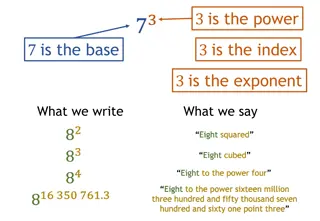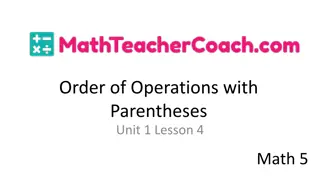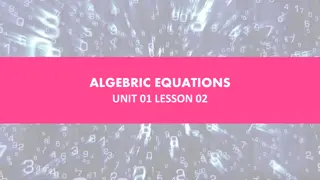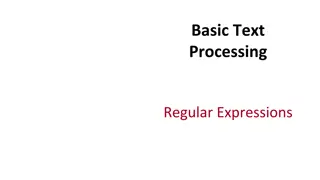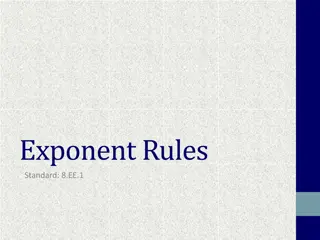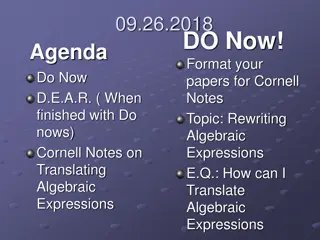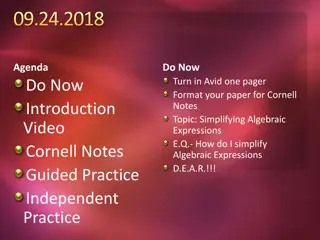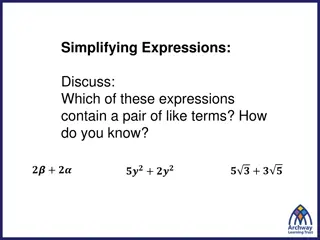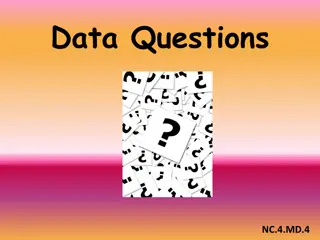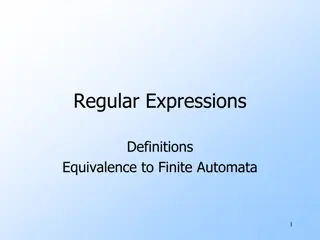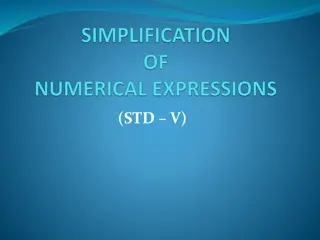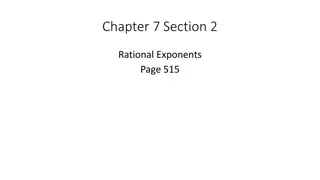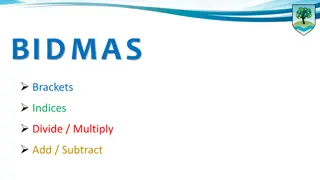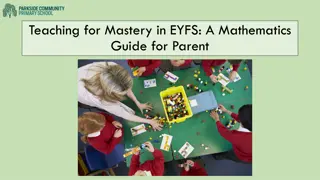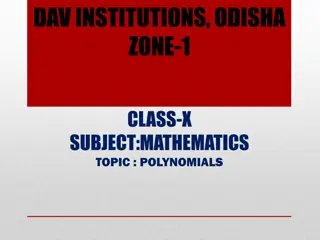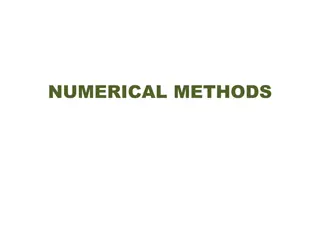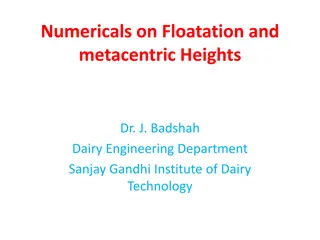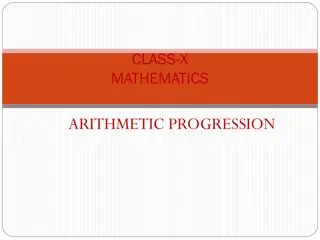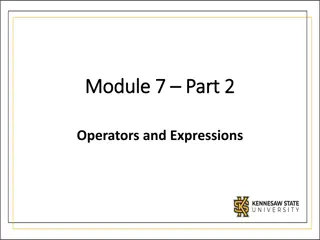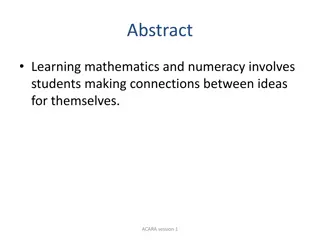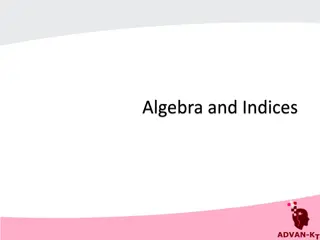Understanding Numerical Expressions in Mathematics
Explore the concept of numerical expressions in math, focusing on recognizing, writing, and interpreting expressions involving addition, subtraction, multiplication, and division. Learn key vocabulary and solve sample problems to enhance comprehension.
Download Presentation

Please find below an Image/Link to download the presentation.
The content on the website is provided AS IS for your information and personal use only. It may not be sold, licensed, or shared on other websites without obtaining consent from the author. Download presentation by click this link. If you encounter any issues during the download, it is possible that the publisher has removed the file from their server.
E N D
Presentation Transcript
Writing and Interpreting Numerical Expressions Unit 1 Lesson 1 Math 5
Writing and Interpreting Numerical Expressions Students will be able to: Recognize numerical expressions. Familiarize the words used to represent operations such as addition, subtraction, multiplication and division. Write a numerical expression that record calculations with numbers given a verbal phrase. Translate numerical expressions into words. Interpret numerical expressions without evaluating them. Compare expressions using visual models.
Writing and Interpreting Numerical Expressions Key Vocabulary: Numerical expression Parentheses Operations Addition Subtraction Multiplication Division Tape diagram
Writing and Interpreting Numerical Expressions What are NUMERICAL EXPRESSIONS? A numerical expression is a mathematical represents a single value. It consists of one numbers and operations. These operations involve Subtraction, Multiplication and Division. phrase that or more Addition,
Writing and Interpreting Numerical Expressions What are NUMERICAL EXPRESSIONS? The numbers and operations that you can mix up to form a numerical expression. picture shows the Also, remember that there should be NO equal sign = in the expression, because that would be a different story !
Writing and Interpreting Numerical Expressions Sample Problem 1: Which among the following is a numerical expression? a. ? + ? + 3 b. 1 + 3 = 2 + 2 c. 4 + 5 3 d. 24 (9 1) Solution: The correct answers are C and D.
Writing and Interpreting Numerical Expressions Writing Numerical Expressions How do I write numerical expressions? In writing numerical expressions from verbal statements, you need to familiarize yourself with the CLUES!!! These clues are words that are used to represent the four operations: addition, subtraction, multiplication and division. These words/phrases are identified on the next slide.
Writing and Interpreting Numerical Expressions Addition Subtraction Multiplication the sum of plus increased by more (than) and total of raised combined added to together add additional in all taken from Division divided (by) average ratio quotient per part shared equally __ out of __ split the difference less than diminish minus decrease (by) go down subtract from reduce drop fewer than left lost multiplied times twice tripled doubled product
Writing and Interpreting Numerical Expressions Example 1: Write a numerical expression given the verbal phrase below: The sum of nine and five multiplied by three Looking at the given example, you have to understand that you need to get the sum of nine and five first, and multiply whatever the answer is to three. This should be done first Then, whatever the answer is the sum of nine and five multiply it by three
Writing and Interpreting Numerical Expressions So how do we write it as a numerical expression? We need to do some sort of grouping, to indicate that one operation must be done first, before doing another. We use open/close parentheses () ,to group the numbers and operations. The operation that must be done first must be enclosed in parentheses. (The sum of nine and five) multiplied by three This must be enclosed in parentheses because the given phrase calls for the sum of 9 and 5 first.
Writing and Interpreting Numerical Expressions So the numerical expression we can get is: The sum of nine and five multiplied by three (9 + 5) 3
Writing and Interpreting Numerical Expressions Example 2: Write a numerical expression given the verbal phrase below: The sum of nine and the product of five and three If you compare it to the first example, both involve the same numbers and the same operations. Example 1: The sum of nine and five multiplied by three Example 2: The sum of nine and the product of five and three
Writing and Interpreting Numerical Expressions Both examples in the previous slide involve numbers nine, five and three, and operations addition and subtraction. But do they really mean the same? BIG NO!!!
Writing and Interpreting Numerical Expressions In Example 2, The sum of nine and the product of five and three , the operation that must be done first is to multiply five and three then add nine to whatever the product is. The grouping will then be: The sum of nine and (the product of five and three) 9 + (5 3)
Writing and Interpreting Numerical Expressions Let s compare the two verbal phrases!
Writing and Interpreting Numerical Expressions Here, we can say that both verbal statements may have exactly the same numbers and may involve that same operations; they mean differently though. Pay close attention to the given phrase and group the numbers with operations that must be done first. The examples in the previous slide will also give DIFFERENT answers when evaluated.
Writing and Interpreting Numerical Expressions Sample Problem 2: Tell whether the given phrases below have the same meaning, or not, by writing their corresponding numerical expression. a. The difference between twenty and twelve divided by two b. The difference between twenty and the quotient of twelve and two
Writing and Interpreting Numerical Expressions Sample Problem 2: Solution: a. The difference between twenty and twelve divided by two (20 12) 2 a. The difference between twenty and the quotient of twelve and two 20 (12 2) The given phrases do not mean the same.
Writing and Interpreting Numerical Expressions Now, let s do it the other way around!!! Translating Verbal Phrases into Numerical Expressions Instead of writing numeral expressions given the verbal phrases, you ll do it the other way around. You are going to translate numerical expressions into words. Remember IMPORTANT!!! Always pay attention to: that the ORDER OF OPERATIONS is very What should be done first?
Writing and Interpreting Numerical Expressions How do I write numerical expressions into verbal phrases? Example 3: Translate ?? (? ?) into words. As mentioned, take note of the order of operations and What should be done first? In this example, which verbal phrase do you think is correct? a. Twenty four divided by eight minus four b. Twenty four divided by the difference of eight and four The correct answer is B.
Writing and Interpreting Numerical Expressions Take note that there are numbers to be grouped in the given example, and should be done first. ?? (? ?) Twenty four divided by the difference of eight and four
Writing and Interpreting Numerical Expressions A on the other hand is incorrect. Twenty four divided by eight minus four Looking at the order of operations, the numerical expression for this verbal phrase is (?? ?) ?.
Writing and Interpreting Numerical Expressions Sample Problem 3: Translate each numerical expression into words and write them in each cloud.
Writing and Interpreting Numerical Expressions Sample Problem 3: Translate each numerical expression into words and write them in each cloud.
Writing and Interpreting Numerical Expressions Sample Problem 3: Translate each numerical expression into words and write them in each cloud. Solution: (Answers may vary) 1. Four times five plus ten. 2. Four times the sum of five and ten 3. Thirty divided by the sum of five and one times the difference of seven and three 4. Thirty divided by five plus the product of one and seven, minus three
Writing and Interpreting Numerical Expressions Interpreting Numerical Expressions How are numerical expressions interpreted without evaluating them? Evaluate means getting the value of a given numerical expression with the use of any given operation, following a correct order. But how is it done without evaluating? Without evaluating, compare the value of: (?? + ?) and ? (?? + ?) To compare the values of the given numerical expressions without evaluating, the use of a visual model such as a TAPE DIAGRAM is used.
Writing and Interpreting Numerical Expressions Using a tape diagram, we can draw the model of (?? + ?) and the model of ? (?? + ?)
Writing and Interpreting Numerical Expressions Without evaluating and by only drawing a model of the given numerical expressions, we can say that: ? (?? + ?) is 5 times as large as (?? + ?)
Writing and Interpreting Numerical Expressions Sample Problem 4: Without evaluating, which do you think has a bigger value? Draw the model to compare. The sum of 12 and 8 tripled or ? ?? + (? ?)
Writing and Interpreting Numerical Expressions Sample Problem 4: Solution: Without calculating, the visual models clearly show that the sum of 12 and 8 tripled and ? ?? + (? ?)have exactly the same value.
Writing and Interpreting Numerical Expressions Sample Problem 5: Compare the given numerical expressions using >, < or =, without calculating. Draw tape diagrams to help you decide. ?? (?? + ?) (?? + ?) ??
Writing and Interpreting Numerical Expressions Sample Problem 5- Solution:
Writing and Interpreting Numerical Expressions Sample Problem 5- Solution: Therefore, ?? (??+?) (??+?) ?? >
Writing and Interpreting Numerical Expressions Sample Problem 6: A pastry box contains 12 pcs of assorted cookies. Paul bought 3 boxes to be given to his parents and 5 boxes for his friends. Draw a tape diagram and write the numerical expression that shows the total number of cookies bought.
Writing and Interpreting Numerical Expressions Sample Problem 6: Solution: Tape diagram: 12 1212 + 1212 12 12 12 The 3 boxes, with 12 cookies each, are for his parents. The 5 boxes, with 12 cookies each, are for his parents.
Writing and Interpreting Numerical Expressions Sample Problem 6: Solution: Numerical Expression: ? ?? + (? ??)


